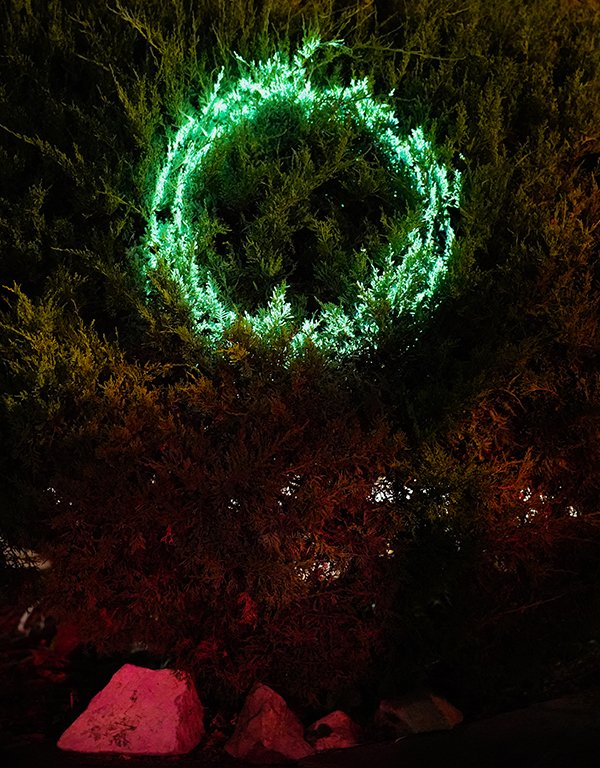Bill Dolson
Santa Fe, NM
“Scanners” | Video Installation
Scanners:Scanners are outdoor video installations which project geometric computer animations onto vegetation and terrain. They are intended to be viewed at night. In its essential state, a simple animation places a vertical white line on a black background, which moves across the frame from side to side. When this animation is projected onto a bush or tree, the line becomes a vertical plane of light scanning across the branches of the “subject,” exposing detailed structure which is normally not perceived. A familiar plant form therefore becomes exotic, even alien, as details of its physical structure are revealed. The effect is almost like that of a medical imaging technique, like a CAT-scan, or even of a dissection, revealing “slices” of the botanical structure. However, since the scanning plane of light is continuously in motion, the visual field is complex and ever-changing. Rather than viewing a static structural image, the viewer experiences a gestalt of the illuminated structure.
A Scanner is human scale, intimately experienced by a lone individual or by a small number of viewers at a time. Each projection is intended to be viewed in near darkness as it illuminates an area of terrain or vegetation just a few yards across, where the light levels are low. While the small projectors use lasers, Scanners are not spectacular; they are perhaps the antithesis of the typical stadium laser show. They are small, modest in size, intimate and subtle.
The definition of scan is to “look at all parts of (something) carefully in order to detect some feature.” While the word scan can mean to examine, it can also mean to contemplate, inquire, investigate, study, or survey.
Scanners replicate and model a significant process of modernity, the creation of lines of demarcation, division, and segmentation; the gridding of the natural world. These artworks provide a direct experience of this process of the segmentation of nature. They make manifest the activity of spatial division, a method by which modernity has organized and understood the natural world. Scanners provide a visceral experience of the mechanisms and limitations of this method of understanding nature.
About the artist: Bill Dolson is an artist, art historian, and computer engineering consultant. His current artwork is involved with the landscape; in the form of large scale land art pieces employing dynamic geophysical processes, at a more human scale involving light and video projections, or via media representation of the landscape. His specific focus is often the atmosphere. His specialization as an art historian is 20th Century. His consulting work is involved with the aerospace sector. His current work as an artist is informed by his work in computer engineering.
Bill has been creating video and computer animation since the early 70s. A long-time resident of New York City, his early collaborators were dancers, fashion designers and filmmakers. In subsequent years, he worked to produce immersive installations and with Ocean Earth Construction and Development, Inc. to propose satellite data-generated solutions to geopolitical problems.
He moved to New Mexico about 20 years ago. As a result of his move he resumed his art practice after a decade-long hiatus with a new focus on the landscape. In 2006-2007, Dolson was an artist in residence at Eyebeam in NYC.




